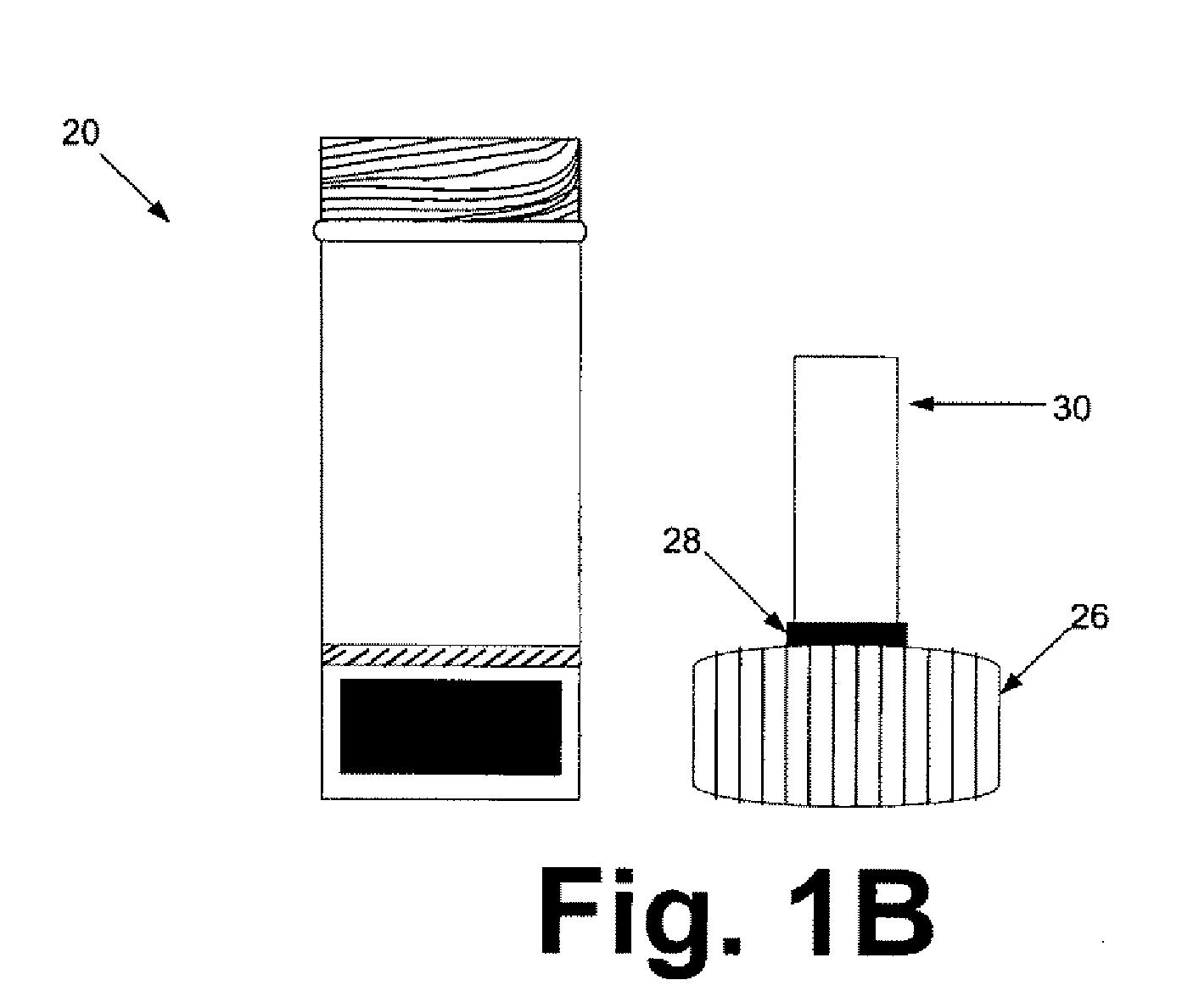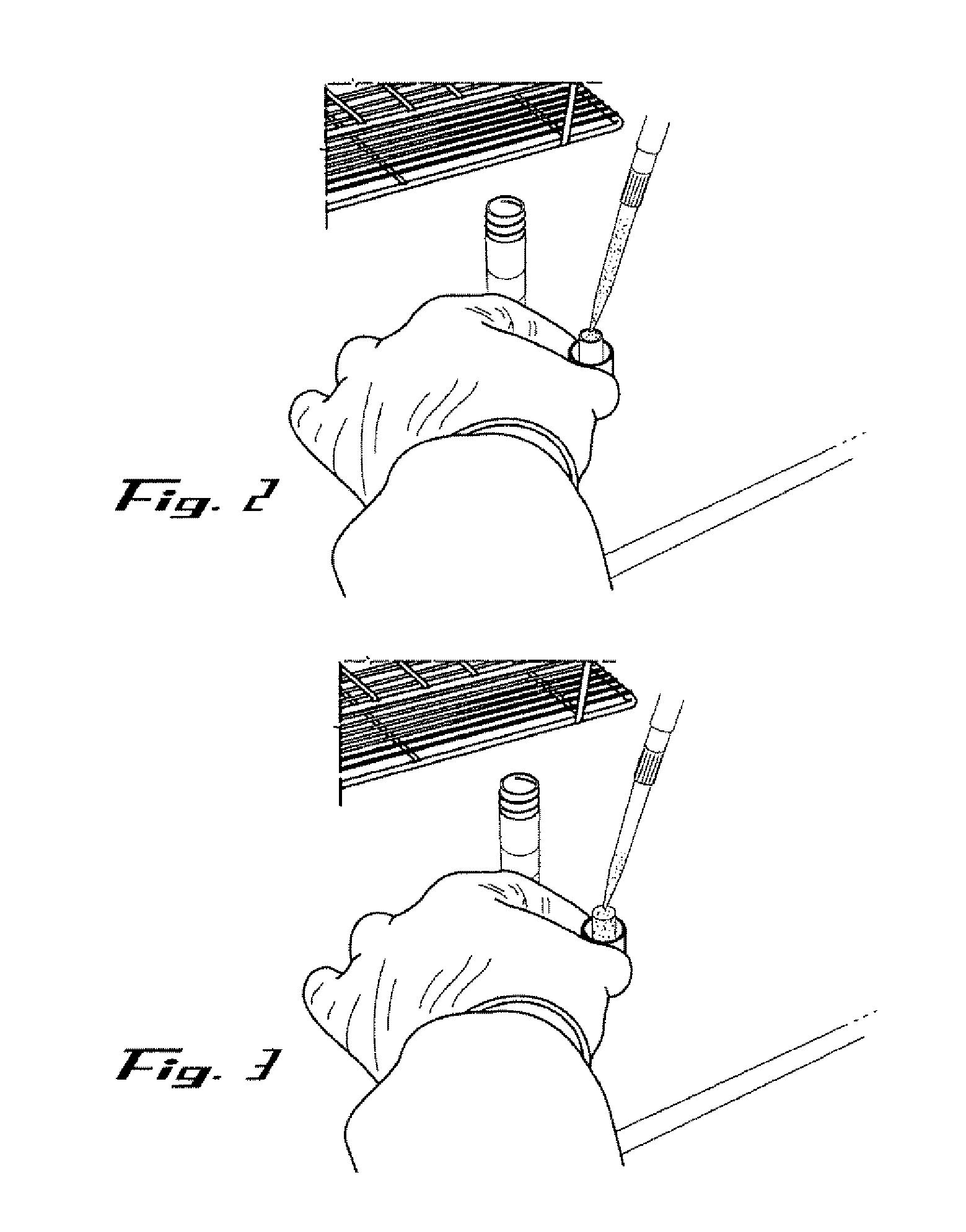Devices and Methods for Collection, Storage and Transportation of Biological Specimens
a technology for biological specimens and devices, applied in the field of biological specimen collection, storage and transportation devices, can solve the problems of loss of samples, danger of infection, and cost of refrigeration, and achieve the effect of safe, convenient and simple devices
- Summary
- Abstract
- Description
- Claims
- Application Information
AI Technical Summary
Benefits of technology
Problems solved by technology
Method used
Image
Examples
example 1
One (1.0) ml Sample Preparation and Device Recovery Kit
Kit Components:
[0067]This example provides a kit for the preparation, transportation, and recovery of thirty-six (36) dry biological specimens from bodily fluids or tissue. Materials and reagents for the preparation and recovery of thirty-six (36) one (1.0) ml samples for dried ambient transportation include the following:
ComponentQuantityDevice Kit containers (tubes)36 eachReconstitution Buffer3 × 13 mlDisposable 3 ml Syringes36 each15 ml Conical Centrifuge Tubes36 each
Storage and Handling:
[0068]Upon receipt, all kit components are stored dry at room temperature (15-25° C.). Only use device container tubes when the indicating desiccant is blue in color. The device kit container tubes should not be if the indicating desiccant appears white or pink in color. Materials such as 1000 μl pipette, 1000 μl sterile DNase-free, RNase-free pipette tips with aerosol barrier, rack for holding 15 ml conical tubes, safety glasses, laboratory ...
example 2
Sample Preparation Using the Device Kit
[0070]The sample preparation steps were performed within a biological safety cabinet using sterile technique and universal precautions relating to the handling of potentially infectious materials. Before beginning the sample preparation process, the protocol of using the device kit that is illustrated in FIGS. 1A & 1B should be familiarized.
[0071]Before loading a sample liquid suspension of biological specimen containing analytes of interest, the cap from the device container was unscrewed, inverted and placed on a clean working surface with the absorbent matrix facing upwards (See FIGS. 1A & 1B). About up to 1 ml of sample fluid was slowly added to the top of the matrix plug and allowed it to fully absorb into the matrix. The device kit matrix loaded with the sample fluid was allowed to air-dry. In general, air-drying within a biological safety cabinet takes approximately 4.5 to 5 hours. Once the sample is completely dry, the cap holding the d...
example 3
Sample Recovery Using the Device kit
[0072]The sample recovery steps were also performed within a biological safety cabinet using sterile technique and universal precautions relating to the handling of potentially infectious materials. Basically, a sterile 3 or 5 ml disposable Luer-Lok™ syringe (provided by the kit) was inserted into a 15 ml collection tube (also provided by the kit). The plunger was removed from the syringe barrel. The absorbent matrix containing the dried specimen was transferred into the syringe barrel by pressing the matrix against the sterile inside of the syringe barrel's mouth with just enough pressure to break it free from the attached cap and allow it to fall freely to the bottom of the syringe (See FIGS. 4 & 5). The syringe barrel with detached matrix plug was placed into a 15 ml conical collection tube, which is further placed into a rack. About 1 ml of Reconstitution Buffer (supplied by the kit) was applied slowly and directly to the top of the matrix plu...
PUM
| Property | Measurement | Unit |
|---|---|---|
| volume | aaaaa | aaaaa |
| volume | aaaaa | aaaaa |
| volume | aaaaa | aaaaa |
Abstract
Description
Claims
Application Information
 Login to View More
Login to View More - R&D
- Intellectual Property
- Life Sciences
- Materials
- Tech Scout
- Unparalleled Data Quality
- Higher Quality Content
- 60% Fewer Hallucinations
Browse by: Latest US Patents, China's latest patents, Technical Efficacy Thesaurus, Application Domain, Technology Topic, Popular Technical Reports.
© 2025 PatSnap. All rights reserved.Legal|Privacy policy|Modern Slavery Act Transparency Statement|Sitemap|About US| Contact US: help@patsnap.com



